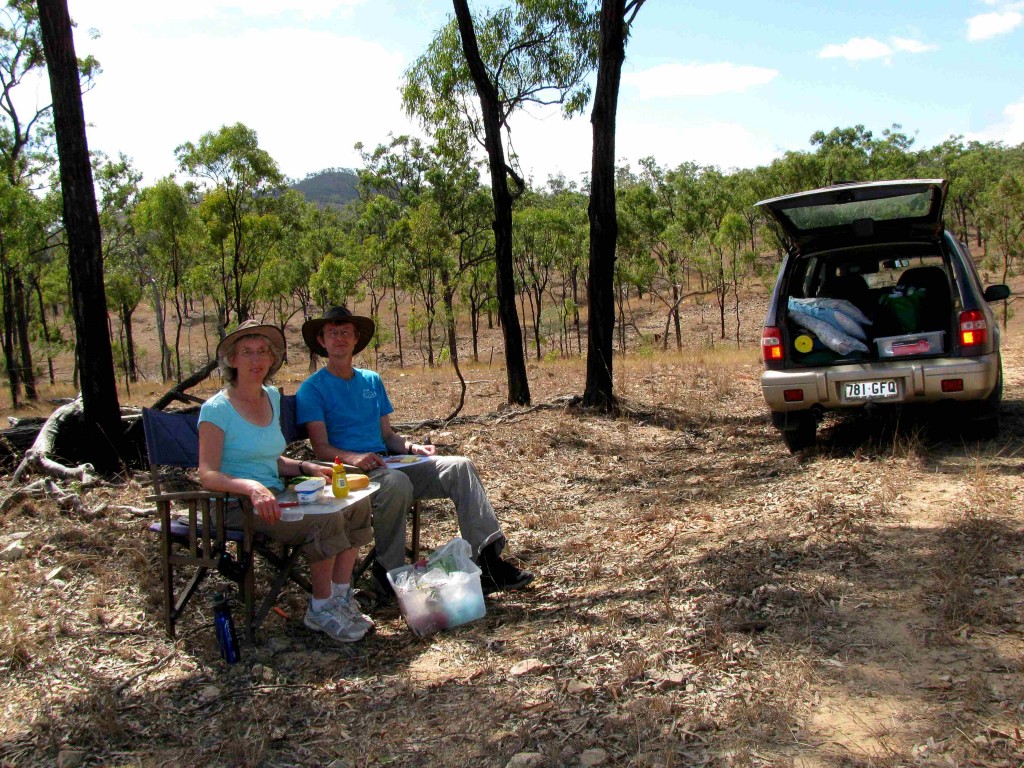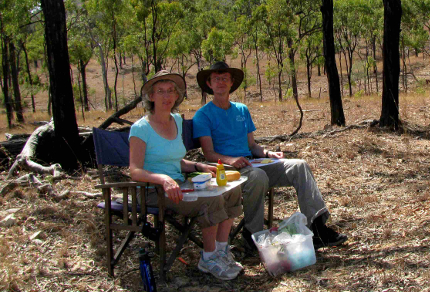In mid-morning, grey cloud hung over Herveys Range as Vilis and I traveled west from Townsville toward Star River and the turn-off for mysteriously-titled Hidden Valley and, farther to the north, Lake Paluma. Rock thrust up through the sparse forest cloaking Herveys Range – that knobby spine of peaks that took bullock teams an entire day to climb in Townsville’s early days.1 Beyond the range’s saddle, the landscape leveled off into a plateau of savannah woodland wrinkled with the indentations of rivers and streams. At Star River, we poked about among river-slanted paperbarks growing in the coarse-sand riverbed, trying to imagine how this waterway, with its 10-metre flood-depth posts beside the highway, had looked during the torrential monsoonal downpours of late January and February.

Lunch Break en route to Hidden Valley (© Vilis Nams)
Beyond Star River, we headed north on a red gravel road posted with warnings of livestock and road trains, the latter blanketing the landscape with dust as they barrelled past us. Each time a road train approached, Vilis pulled off the road and stopped to await the clearing of the enveloping silty cloud that rendered visibility nonexistent for at least ten seconds. Then we crept back onto the road and drove through Zig Zag Station, a vast holding of rocky hills vegetated with spinifex grass and sparse trees, that landscape easing northward into wooded rangeland with grasses grazed to the ground.
Hidden Valley, so alluring on a map, was no more than a dry, dusty collection of houses in the middle of nowhere. Beyond it, however, the parched landscape gave way to greener grass and denser stands of trees, including towering blue gums with smooth, milky-blue bark that rivaled the mountain ashes in Victoria’s Yarra Ranges National Park for lofty, straight-trunked beauty.
In late afternoon, we arrived at Lake Paluma, a man-made lake created by the 1958 damming of Running River to create an additional water supply for Townsville and Thuringowa. Welcome swallows performed their insect-hunting dives and half-rolls over the water, while eastern whipbirds whistled whip-snap calls from within the rainforest bordering the lake. We erected our tent in the shade of the forest and explored our environs, scrambling over granite bedrock and boulders in the nearly dry riverbed below the dam and strolling across the barrier top. The latter offered an excellent vantage point for birding and for views of forested hills and enticing valleys so rich with vegetation as to belong to another world compared with the bleached, dry savannah woodland through which we drove earlier in the day.
Again, as always, the rainforest felt like a breath of sweet freshness oozing exotic biodiversity – the strangler figs and tangled vines; the sulphur-crested cockatoos, crimson rosellas, and rasping screeches of riflebirds. And again, as always, the rainforest provided us with shade, a commodity in scarce, slivered supply in the savannah woodland that surrounds Townsville and stretches westward in a seemingly endless earth-scalp of rough grasses and stunted trees.
Reference:
1. Dr. Shelley Greer. Archaeology of the Townsville Region. JCU at the Library lecture series, Townsville City Libraries, Aitkenvale, May 20, 2010.
Today’s birds: rainbow bee-eaters, masked lapwings, rock doves, mynas, magpie-larks, straw-necked ibis, Australian magpie, black kites, magpie geese, rainbow lorikeets, blue-faced honeyeaters, yellow-throated miner, noisy friarbird, brown honeyeaters, peaceful dove, Australian raven, willie wagtail, whistling kites, Torresian crow, Austrlalian brush-turkeys, white-browed robin, white-throated treecreepers, grey-headed robins, grey fantail, *bridled honeyeaters, *yellow-throated scrubwren, white-browed scrubwrens, crimson rosellas, Lewin’s honeyeater, golden whistlers, welcome swallows, sulphur-crested cockatoos. (*denotes lifelist sighting)


